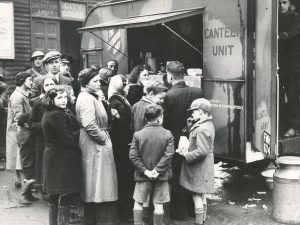More than 11,000 people already helped by The Salvation Army in Myanmar.
MYANMAR
THREE weeks after Cyclone Nargis ripped through southern Myanmar (Burma) on May 2, The Salvation Army is continuing to distribute relief supplies and is planning a larger-scale assistance program. Major Mike Caffull, International Emergency Services field operations officer, recently traveled to Myanmar and met with 50 local relief team members on how to conduct assessments.
Immediately after the storm, local Salvationists began making daily visits to some of the most difficult-to-reach areas. Since commencing the relief work, The Salvation Army has distributed nearly 6,000 kilos of rice and more than 3,000 kilos of noodles, as well as a number of other food items. Salvation Army teams have provided more than 11,000 people with basic supplies including food, tarpaulins, drinking water and clothes. These figures do not include the many hundreds of people who, in the immediate aftermath of the cyclone, lined up outside The Salvation Army’s children’s homes home in Yangon to receive clean drinking water from their wells.
Travel to remote areas
Commissioner David Bringans, territorial commander for the Singapore, Malaysia and Myanmar Territory, reports that local personnel have been able to travel out from Yangon about six hours south into the impacted areas.
Major James Aaron, regional officer of The Salvation Army in Myanmar, says: “We have been sad to see so many people suffering through bereavement and loss, wandering around, not knowing where to turn for help, with no homes or possessions. Yet to see some of them smiling when our teams visit with only small assistance is wonderful.” Aaron leads one of the teams himself and has been personally involved in the response to victims.
Long-term needs
Although communication has been difficult, Caffull, who has visited disaster scenes to assess current and long-term needs, has confirmed earlier reports that The Salvation Army has been helping victims almost every day since the cyclone. Salvationists hope to gain access to the Ayeyarwady Division of the country, where the worst of the storm hit and where reports state that up to 60 per cent of people have still not received any assistance.
As the five teams of local Salvationists—boosted by the recent training they received shortly after Caffull’s arrival—continue to make their visits with food and clothing, they are finding more ways in which people need help. Plans are in place for an international Salvation Army team of experienced emergency responders to make their way to Myanmar, so the caring work already under way can be supplemented and developed.
International assistance
Caffull reports: “The international Salvation Army should be proud of its colleagues in Myanmar who are giving of themselves sacrificially to help many people who have been left with nothing. We need to help them do more and hope to be able to deploy an experienced team to help. The need is great but so are the resilience of the people and the compassion of the Myanmar Salvationists.”
Donations to support the work of The Salvation Army in Myanmar can be made online at www.salvationarmy.org.
The death toll from Cyclone Nargis may top 100,000 with tens of thousands also missing. Damage is estimated at over U.S. $10 billion, making it the most damaging cyclone ever recorded in the area, and the country’s worst, most deadly, natural disaster ever.
CHINA
In China, following the Sichuan earthquake of May 12, The Salvation Army has been active in relief efforts and needs assessments, working with the Chinese authorities. The Army immediately transferred HK$3-4 million to purchase relief supplies. More funds have since been donated.
Hong Kong teams
After the quake, a team from the Hong Kong and Macau Command traveled to Chengdu, Sichuan Province, an area where The Salvation Army has experience from previous programs. Major Tommy Chan, senior relief officer, leads the team, which immediately moved into three affected villages, distributing rice, biscuits and drinking water.
Chan stated that the destruction was terrible, making assessments especially difficult. He reported that the most urgent needs were supplies of water purifier pills, surgical masks, plastic gloves and cotton gloves.
A second team of relief workers arrived in Sichuan on May 22, including Lt. Colonel Merv Rowland, officer commanding of the Hong Kong and Macau Command, with responsibility for work in Mainland China. The team is directly handing the food, drinking water and water purifier pills to survivors, and will give medical materials to the NGOs liaison office of the Sichuan government.
Extensive losses
Recent figures released by the Chinese government report more than 68,500 dead and over 365,000 injured; many thousands are missing, possibly still buried under the rubble. About 4.8 million are now homeless, though that number could be as high as 11 million.
Salvation Army representatives, with other religious organizations, are planning a trauma counseling program. In addition, Rowland and relief coordinator Envoy Simon Wong (community relations director for the Army in Hong Kong) are meeting with the government’s Civil Affairs Department to discuss rehabilitation needs.
Financial responses
In Hong Kong, The Salvation Army held street appeals at four locations across the territory on May 16 for the Sichuan earthquake emergency relief operation. More than 100 volunteers, including the elderly and youth members of the Army’s social service units, corps officers, students and amateur magicians, stood on the street and approached the public for donations. People responded generously, and Starbucks supported the volunteers’ efforts with drinks and snacks.
Long-term rehabilitation
Major Cedric Hills, International Emergency Services coordinator, states: “The Salvation Army is well placed to participate in the longer-term rehabilitation needs as our local personnel have experience of working in this particular region. The financial appeal launched in Hong Kong has been received very positively. Already local donations have exceeded HK$6.5 million (US$835,000). While we are grateful for this tremendous public support and the trust placed in The Salvation Army, we realize the needs in the area will be extensive.”
Please donate online at www.salvationarmy.org.
The Sichuan earthquake was the deadliest and strongest earthquake to hit China in over 30 years. Two aftershocks followed, leading to the collapse of 420,000 more buildings. A May 25 aftershock of 6.0 on the Richter scale struck northeast of the original epicenter, bringing more deaths and injuries and billions of dollars in more damage.
Compiled by Karen Gleason from communications from Major Tony Ma in Hong Kong and International Emergency Services reports.











